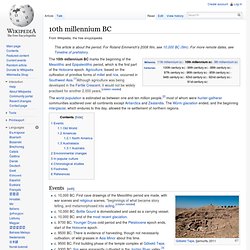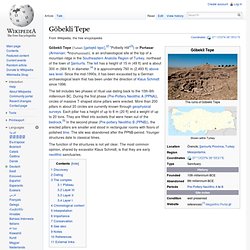

Human Era. The Holocene calendar, also known as the Holocene Era (HE) or Human era, is a year numbering system that adds exactly 10,000 years to the currently world-dominant Anno Domini (AD) or Common Era (CE) system, placing its first year near the beginning of the Holocene epoch and the Neolithic revolution.

Human Era proponents claim that it makes for easier geological, archaeological, dendrochronological and historical dating, as well as that it bases its epoch on an event more universally relevant than the birth of Jesus. The current year of 2014 AD can be transformed into a Holocene year by adding the digit "1" before it, making it 12014 HE. The Human Era was first proposed by the scientist Cesare Emiliani in 1993 (11993 HE).[1][2][3] Motivation[edit] Cesare Emiliani's proposal for a calendar reform sought to solve a number of alleged problems with the current Anno Domini era, which number the years of the commonly accepted world calendar. Conversion[edit] See also[edit] 10th millennium BC. The 10th millennium BC marks the beginning of the Mesolithic and Epipaleolithic period, which is the first part of the Holocene epoch.

Agriculture, based on the cultivation of primitive forms of millet and rice, occurred in Southwest Asia.[1]Although agriculture was being developed in the Fertile Crescent, it would not be widely practised for another 2,000 years. [citation needed] Events[edit] c. 10,000 BC; First cave drawings of the Mesolithic period are made, with war scenes and religious scenes, *beginnings of what became story telling, and metamorphosed into acting. Old World[edit] Americas[edit] North America[edit] Australasia[edit] Australia[edit] Environmental changes[edit] c. 10,000 BC: c. 9700 BC: Lake Agassiz forms c. 9700 BC: Younger Dryas cold period ends.
In popular culture[edit] Chronological studies[edit] [edit] Jump up ^ Roberts (1994)Jump up ^ "Historical Estimates of World Population". Jericho. Jericho (/ˈdʒɛrɪkoʊ/; Arabic: أريحا ʾArīḥā [ʔaˈriːħaː] ( ); Hebrew: יריחו Yeriẖo) is a city located near the Jordan River in the West Bank.

It is the administrative seat of the Jericho Governorate. In 2007, it had a population of 18,346.[2] The city was occupied by Jordan from 1949 to 1967, and has been held under Israeli occupation since 1967; administrative control was handed over to the Palestinian Authority in 1994.[3][4] It is believed to be one of the oldest inhabited cities in the world.[5][6][7] Archaeologists have unearthed the remains of more than 20 successive settlements in Jericho, the first of which dates back 11,000 years (9000 BCE),[8] almost to the very beginning of the Holocene epoch of the Earth's history. Jericho is described in the Hebrew Bible as the "City of Palm Trees". Etymology[edit] Jericho's Arabic name, ʼArīḥā, means "fragrant" and derives from same Canaanite word Reaẖ, of the same meaning as in Hebrew.[11][12][13][14] Göbekli Tepe.
The function of the structures is not yet clear.

The most common opinion, shared by excavator Klaus Schmidt, is that they are early neolithic sanctuaries. Discovery[edit] The site was first noted in a survey conducted by Istanbul University and the University of Chicago in 1963. American archaeologist Peter Benedict identified it as being possibly neolithic[6] and postulated that the Neolithic layers were topped by Byzantine and Islamic cemeteries. The survey noted numerous flints. In 1994, Klaus Schmidt, now of the German Archaeological Institute, who had previously been working at Nevalı Çori, was looking for another site to lead a dig. The following year, he began excavating there in collaboration with the Şanlıurfa Museum. Dating[edit] View of site and excavation The imposing stratigraphy of Göbekli Tepe attests to many centuries of activity, beginning at least as early as the epipaleolithic, or Pre-Pottery Neolithic A (PPNA), in the 10th millennium BC.